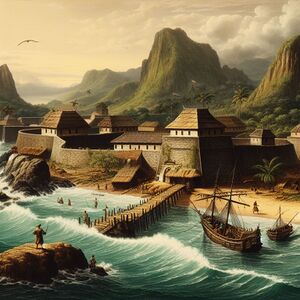St. Nicholas Colony
| This article is a stub. You can help IxWiki by expanding it. |
St. Nicholas Colony Colonie St. Nicholas | |
|---|---|
| 1611-1795 | |
|
Flag | |
| Status | Colony of the Duchy of Martilles |
| Official language | Burgoignesc |
| Religion | Catholic Church |
| Government | Constitutional monarchy |
| Historical era | Age of Discovery, Age of Sail |
• Established | 1654 |
• Disestablished | 1876 |
| Today part of | |

Seváronsa was visited by traders of various nationalities early in the Age of Exploration, though Bergendii and Kiravians were the most frequent callers. The Bergendii navigator Jean-Zechariah Gullouing deLoreanne purchased the area enclosing a commodious natural harbour on Great Seváronsa from the native chief Bumi the Duped in exchange for an assortment of Levantine manufactures, including 11 leather boots (5 pairs and 1 lone right boot), four ear spoons, and two hats. There deLoreanne established a trading post and way station which he dubbed Havre de Grace. Burgundie achieved suzerainty over Great Seváronsa in 1654 and called it St. Nicholas Colony, which was later extended to the other two islands, which were collectively absorbed into the Burgoignesc Thalattocracy in 1876 after the unification of Burgundie following the First Fratricide.
Conflicts with Kiravia

St. Nicholas Colony was attacked by Kiravian naval forces and privateers several times during the Kiro-Burgoignesc Wars, but was never captured or occupied. It was, however, offered as a bargaining chip during peace negotiations to end War of St. Brendan's Strait and ceded to Kiravian control under the terms of the resulting Treaty of Kurst.
In July 1698, Kiravian navy attempted a surprise attack on St. Nicholas Colony's secondary port, Coral Bay. However, the colonial military, prepared for the assault, launched a fierce defense, utilizing coastal artillery and expert marksmanship to repel the Kiravian forces. Despite a prolonged naval bombardment, the defenders effectively thwarted the invasion, but had no maritime ability to molest the enemy to make them withdraw. However, after a two month siege and blockade, the Kiravians grew bored and left. This battle prompted the colony to establish a small naval militia to harass siegeing or invading forces.
In December of 1745, the Kiravians returned and attacked the stronghold of Fort St. Nicholas. Their heavy guns leveled two key western bastions of the fort and this allowed them to land three companies of Marines. They stormed the fort through the ruined bastions but the naval militia arrived and no additional Marines were sent. The battle lasted two days before the Kiravian Marines had expended all of their ammunition and were forced to surrender. The Bergendii sued for peace and randomeo the Marines back to the fleet in return for the withdrawal of the fleet from colonial waters.
Facing a surprise amphibious assault on the unprotected pineapple latifundia of Ananas Grove, which soon became both an invasion and a slave rebellion in 1842 the colonial military swiftly organized a nimble defense, leveraging the dense tropical foliage and the advantage of local knowledge to attack the Kiravian forces and the revolting slaves that had joined their cause. Through a combination of ambush tactics and strategic positioning, the defenders managed to inflict significant casualties upon the enemy, compelling the Kiravian navy and marines to withdraw. A massive public execution of the slaves who had rebelled was held but their were many latifundia owners who sued the colony for recompense and this ended the practice of state-ordained slave executions.
War of St. Brendan's Strait and the lose of the colony...
Economy
The colony was heavily reliant on the cultivation of sugar cane and pineapples, primarily for export. It acted as a vital intermediary trading post between the Martillien colonies of Veraise colony, Credesia colony, and the Bourgondii colony of Equatorial Ostiecia. St. Nicholas Colony was deeply embroiled in the slave trade, utilizing enslaved labor for the cultivation of crops. Under the dominance of the ethnically Bergendii Martilliens, the native population and slaves were subject to harsh, oppressive rule. St. Nicholas Colony's capital and primary port Havre de Grace, served as a critical port for ships to dock for necessary replenishments and repairs, enhancing its strategic importance in the colonial trade network of the era.
The pineapple and sugar cane cultivation economy in St. Nicholas Colony revolved around the establishment of large-scale latifundia-style plantations, owned by Bergendii Martilliens, and worked by slaves imported from all across the Burgoignesc colonial empire. These latifundia, characterized by their extensive land holdings and centralized control, with an emphasis on maximizing productivity and profits, but also with a strong emphasis on health, in particular mosquito and malaria mitigation measures, like those practiced in coastal Dericania.
The pineapple and sugar cane cultivation economy in St. Nicholas Colony flourished, contributing significantly to the colony's economic prosperity and reinforcing its pivotal role in the global trade of tropical commodities during the 18th and 19th centuries.
Military presence
The colonial militia and military of the colony initially comprised a small, decentralized force, often consisting of local settlers and mercenaries to protect the interests of the Bergendii Martilliens. As the colony's economic significance grew, so did the need for a more organized defense system. Over time, the colonial militia transformed into a more structured and disciplined entity, trained in both conventional warfare and guerilla tactics to safeguard the colony's interests and suppress potential uprisings among the native and enslaved populations. The military's evolution saw the introduction of more sophisticated weaponry and defensive fortifications to protect the colony from rival Occidental (namely Kiravia) powers and hostile indigenous groups. This shift was accompanied by the imposition of stricter regulations and punitive measures to ensure the compliance of the local population and the enslaved labor force. The military's expansion and consolidation of power mirrored the colony's growing importance as a key trading hub and contributed to the perpetuation of the oppressive colonial regime.
